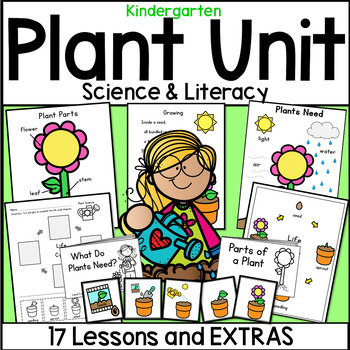Kindergarten PLANT Unit with Plants Theme Literacy Activities Books Poem Writing
- PDF
What educators are saying
Description
All About Plants: Plant UNIT Plants ELA Activities with Lesson Plans
150 Pages LOW PREP
Complete Thematic Unit for Plant Science Includes Common Core Aligned ELA Lessons Activities and Plant Assessment! SEE PREVIEW FOR ALL THUMBS
Plant Science Concepts Include:
- How a Plant Grows,
- Sequencing Plant Life Cycle,
- Parts of a Plant,
- What Plants Need to Grow,
- Growing a Plant ... and more!
Plants Literacy Activities Include:
- Plant Poetry, RI.K.10, L.K.6
- Writing "How-To" Plant a Seed W.K.2
- Writing to Inform (Needs of Plants) W.K.2
- 3 Printable Mini-Books: Non-fiction Information Books* RI.K.1,2 and 3, RF.K.4
Topics: Plant Parts, Plant Needs, How a Sunflower Grows
- Fiction Reader with Plant Facts* RL.K. 1,2,3, RF.K.4
- Language Activities RL.K.2, RL.K.2b, L.K.6
- Text-to-Text Comparisons RI.K.9, RL.K.9
*These 4 Easy-Print Texts Include Guided Reading Plans, Word Cards, and Draw and Write Response Pages RF.K.3c, L.K.1, L.K.2
Also Includes:
-Plant Craft
-Interactive Plant Song with Stick Puppets
-Plant Display Bulletin Board Pieces
Features:
-17 Complete Lesson Plans Include Outcome Objectives
-Engaging Worksheets
-Extra Worksheets to Use for Independent Work or at your Science Center
-Projectable / Printable Anchor Charts / Teaching Images
-Assessment
-Very Low Prep!!!
-PROMO PRICE I hope you will find it valuable and take the time to review.
Timing is flexible!
-Implement this resource by doing one lesson per day for 17 days.
-Lessons can be combined within a day to complete the unit in 10-15 days (or less if you choose not to complete some lessons).
-This resource can also serve as a supplement to your existing plant unit!
Unit Outline:
Lesson 1: Introduction.: What Are Plants?
Outcome Objective: TSW: (The student will) identify pictures of plants.
Lesson 2. What Parts Do Plants Have? Science Learning
Outcome Objective: TSW label the parts of a plant.
Lesson 3: What Parts Do Plants Have? Non-Fiction Printable Text RI.K.1, RI.K.2 RI.K.3
Outcome Objectives:
TSW name the parts of a plant.
TSW draw a plant and label the parts.
Lesson 4. Plants grow from seeds of the same kind of plant.
Outcome Objective:
TSW identify seeds within a plant .
TSW draw to show that a seed will grow into the same kind of plant it came from.
Lesson 5: How Do Plants Grow? Science Learning
Outcome Objective:
TSW describe the life cycle of a plant by sequencing pictures and using oral language.
Lesson 6: How a Plant Grows: Non-Fiction Text RI.K.1, RI.K.2 RI.K.3
(Includes Color and BW Reader)
Outcome Objective:
TSW order stages of plant growth.
Lesson 7: What Do Plants Need to Grow? Page 74
Outcome Objective:
TSW identify 4 things plants need to grow.
Lesson 8: What Do Plants Need? Graphic Organizer
Outcome Objectives:
TSW identify the needs of plants and record them using a combination of drawing and writing on a graphic organizer.
TSW will use oral language to describe the needs of plants.
Lesson 9: Writing to Inform: What Plants Need to Grow
Outcome Objectives:
TSW: Use a combination of drawing and writing to compose an informative text to provides a topic and details. W.K.2.
Lesson 10:. What Do Plants Need to Grow? / Literacy Activity: Poetry
Outcome Objectives:
TSW Identify 4 things plants need to grow.
Lesson 11:. What Do Plants Need to Grow? / Literacy Activity:
Poetry Day 2 Oral Language Cards: Describe Plant Needs to a Partner
Outcome Objectives:
TSW Describe 4 things plants need to grow.
Lesson 12: Growing a Plant from a Seed: Sequencing
Outcome Objective:
TSW sequence pictures to tell steps in order “How to Grow a Plant”, including giving a plant what it needs to grow.
Lesson 13: Growing a Plant from a Seed: Sequencing
Outcome Objective:
TSW use drawing and writing to inform the reader how to grow a plant. W.K.2
Lesson 14 How to Grow a Plant Fiction Reader with Plant Facts
Learning Outcome:
TSW identify facts in a fiction text.
Lesson 15 and 16: Literacy Activity: Text-to-Text Comparison
Learning Outcome:
TSW participate in a group discussion including analyzing features of 2 texts on the same topic, stating similarities and differences between the two texts.
Lesson 17: Review and Assessment
Review the teaching images for plant parts and plant needs. Re-read the included texts together. Then do a quick assessment to allow learners to demonstrate their learning.
Assessment: 2 Options
Assessment Option 1
Draw a line from the name of each plant part to where it is shown on the picture.
Color the pictures that show what plants need to grow.
Assessment Option 2
Learners will write to list plant needs and label plant parts.
Additional Resources:
- Plant Song with Puppets: Page 132
- Learning Display / Bulletin Board Pieces: (2 Options) Page 137
- Plant Craft Page 153





